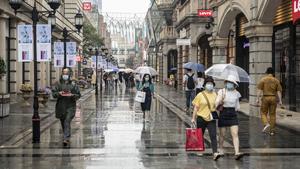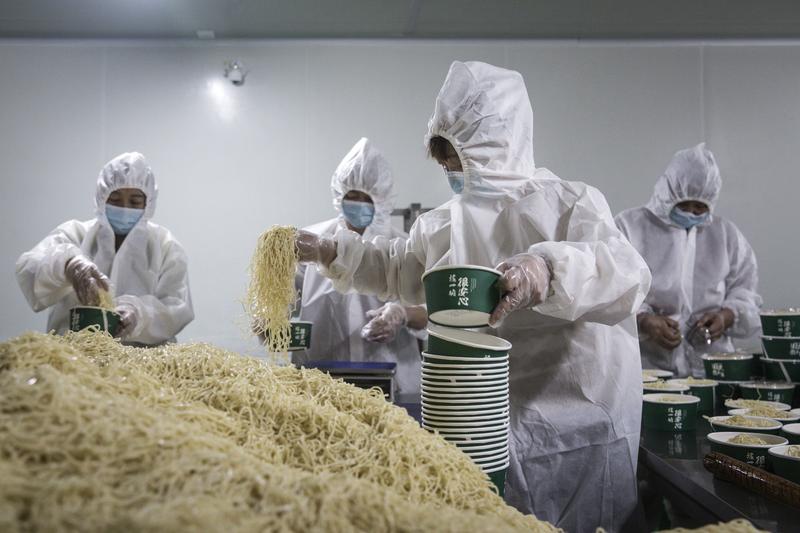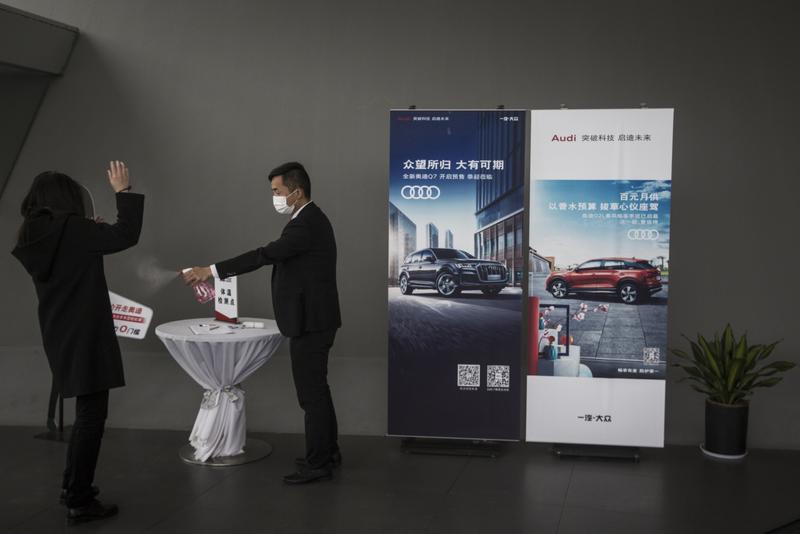 In this April 30, 2020 photo, pedestrians wearing protective masks walk with umbrellas past stores in Wuhan, Hubei Province, China. (Qilai Shen / Bloomberg)
In this April 30, 2020 photo, pedestrians wearing protective masks walk with umbrellas past stores in Wuhan, Hubei Province, China. (Qilai Shen / Bloomberg)
Three months after it reopened its economy, Wuhan’s uneven recovery offers a glimpse of the hard road back to normality for cities after containing the coronavirus.
The trajectory of Wuhan’s economy and the rest of China show the post-virus recovery will be rapid albeit on a two-track path. Small outbreaks of new infections will likely continue to take place during the recovery, but it probably won’t impact broad economic momentum.
Wen Bin, researcher, China Minsheng Banking Corp
As of May, factory output, retail sales and exports in the city stayed below last year's levels. That’s even though some factories worked throughout the lockdown and normal activity had resumed by April. Private consumption continued to lag factory production, mirroring the divergence seen across China.
The end of Wuhan’s quarantine on April 8 was a triumphant moment for China and an important show of confidence that it had successfully contained the deadly virus. While factories and offices quickly got back to business, consumers were slower to return, with residents cautious and habits such as cooking at home and shopping online persisting after the 76-day lockdown.
Then, just as people were beginning to venture outside more -- with social distancing and temperature checks a new regular fixture -- the sudden emergence of a new cluster of infections in May once again put the city on edge. Restrictions returned, and the local government tested the entire population of 11 million in just two weeks. Since then, the city hasn’t reported a single case.
ALSO READ: Value of China's new economy equals 16.3% of GDP

“The trajectory of Wuhan’s economy and the rest of China show the post-virus recovery will be rapid albeit on a two-track path,” said Wen Bin, a researcher at China Minsheng Banking Corp in Beijing. “Small outbreaks of new infections will likely continue to take place during the recovery, but it probably won’t impact broad economic momentum.”
Recent torrential rain in Wuhan has also made it harder for consumption to recover, Wen said. The downpours and resulting floods in southern China have affected more than 30 million people and caused 61.8 billion yuan (US$8.8 billion) in economic losses, China Central Television reported on Friday, citing government data.
Passenger numbers on the Wuhan Metro are still less than half the pre-virus level, though that is picking up steadily. One reason could be that people are opting to drive instead of take public transport to avoid coming into contact with strangers. Car dealers told Bloomberg in April that they were seeing strong demand in the wake of the virus.

Authorities have rolled out measures to stimulate growth, including 500 million yuan in shopping vouchers, cash payments to some households, and tax breaks until the end of the year. The central government also promised to expand free-trade zones in Hubei province, of which Wuhan is the capital, to lure investment back to the region.
Consumer habits
The mass testing campaign was also a big confidence booster, according to restaurant owner Xiong Fei, who operates five establishments serving different cuisines across the city. His restaurants saw the biggest number of customers in May the day after Wuhan announced the results of the operation, he said.
“Even a tiny flare-up could cause panic among people that directly stops them from dining out,” said Xiong, who still hasn’t reopened the five other restaurants he owns. Xiong said profits have dropped as much as 80 percent because he has to spend more money on marketing and promotions to lure hesitant diners.
Conversely, the changing consumer habits are benefiting those catering to people who prefer to eat at home.
Yu Yang, who owns a factory that produces an instant version of “hot dry noodles,” a local favorite, is back to selling the 7,000 to 8,000 bowls a day he moved before the virus. With more people buying the pre-made dish online and in bulk, he’s expanded his online business and began selling in the nearby city of Changsha.
 In this April 7 2020 photo, workers wearing protective suits, masks and gloves pack hot dry noodles into containers at a noodle factory in Wuhan, Hubei province, China. (PHOTO / BLOOMBERG)
In this April 7 2020 photo, workers wearing protective suits, masks and gloves pack hot dry noodles into containers at a noodle factory in Wuhan, Hubei province, China. (PHOTO / BLOOMBERG)
Trade dependence
As a manufacturing hub, Wuhan has seen a surge in trade since the reopening. The value of Wuhan’s exports and imports rose 19.3 percent in May from a year earlier, the fourth fastest pace in China, according to local customs data.
Orders of protective gear and medical supplies helped drive the surge in overseas shipments, with masks and other textile products increasing sevenfold. Wuhan is also home to technology companies including memory-chip giant Yangtze Memory Technologies and Lenovo Group Ltd’s key manufacturing plant, which helped boost imports of mechanical equipment such as semiconductors and circuits by 21 percent in May.
READ MORE: Economy poised to make quick recovery
 In this April 6, 2020 photo, an employee wearing a protective mask sprays a colleague with disinfectant inside an Audi AG dealership in Wuhan. (PHOTO / BLOOMBERG)
In this April 6, 2020 photo, an employee wearing a protective mask sprays a colleague with disinfectant inside an Audi AG dealership in Wuhan. (PHOTO / BLOOMBERG)
But exporters who rely on consumption-fueled industries are suffering. Benny Xiao, director of international operations at Wuhan Boyuan Paper & Plastic Co, which mainly sells cups to airlines and hotels, said his company doesn’t have a single order from the US, Europe and Southeast Asia until at least August.
The outlook is brighter for Yao Jun, founder of Wuhan Welhel Photoelectric Co which makes helmets and face shields. Orders from South America for protective gear have doubled as coronavirus cases increased, while her industrial customers in the US and Europe haven’t cut orders drastically.
“Business is very good now,” said Yao. “Wuhan has finally stepped out of the virus haze.”



